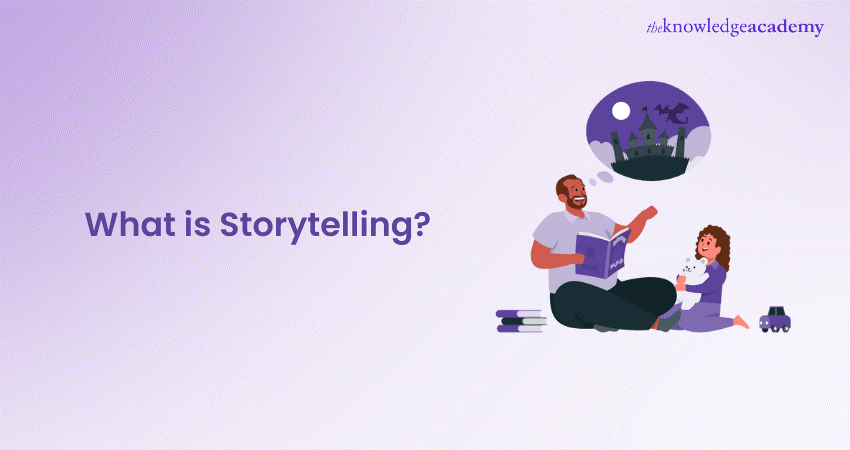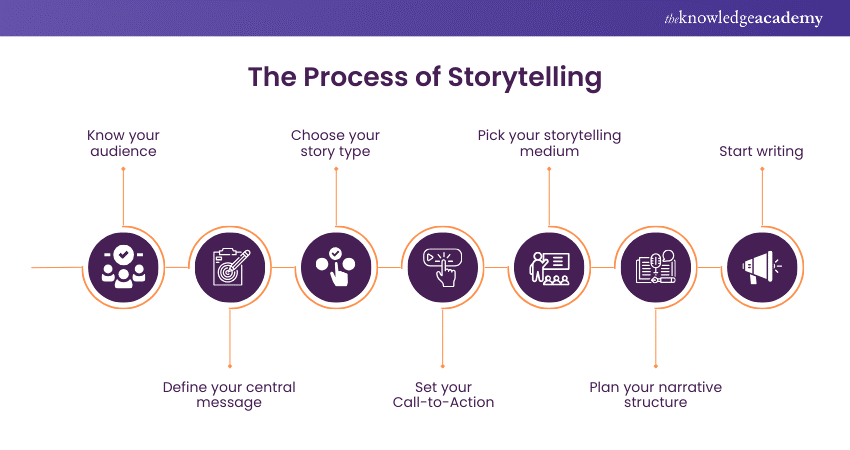We may not have the course you’re looking for. If you enquire or give us a call on 01344203999 and speak to our training experts, we may still be able to help with your training requirements.
Training Outcomes Within Your Budget!
We ensure quality, budget-alignment, and timely delivery by our expert instructors.

When it comes to engaging an audience, capturing their attention, and conveying a message, nothing beats the power of Storytelling. However, Storytelling is not just about telling tales or anecdotes, it is a skill that can be learned and mastered that can transform the way you communicate, persuade, and inspire. But do you know exactly What is Storytelling, and why is it so crucial in communication?
If you are interested in learning more about it, then this blog is for you. In this blog, you will learn What is Storytelling, its importance, and the processes involved. Let’s delve in to learn more!
Table of Contents
1) Understanding What is Storytelling
2) The purpose of Storytelling
3) The process of Storytelling
4) Tips for effective Storytelling
5) Conclusion
Understanding What is Storytelling
Storytelling is the art of conveying narratives through words, visuals, or experiences to engage, inform, or entertain an audience. It is a powerful and timeless practice that captures human emotions, experiences, and ideas.
Thus, it enables us to connect with others, convey messages effectively, and inspire action. Whether through spoken words, written stories, visual presentations, or immersive experiences, Storytelling plays a pivotal role in human communication and expression.
The purpose of Storytelling
Now that you are aware of What is Storytelling, let’s understand its purpose. From igniting inspiration to fostering ideas, Storytelling serves as a versatile and indispensable tool in human communication. Let's delve into some of its crucial purposes below:
Making abstract concepts tangible
Through Storytelling, complex and abstract ideas are brought down from the clouds of obscurity and made relatable and understandable. It's like disassembling a perplexing puzzle and presenting its pieces in a simplified form.
This process allows people to grasp these once-elusive concepts with greater ease and clarity. For instance, when explaining intricate scientific theories, stories can provide real-world examples that breathe life into these otherwise esoteric ideas.
Stories foster and mould ideas
Storytelling transcends the mere conveyance of information; it is a potent instrument for nurturing and shaping ideas. Imagine stories as the fertile soil where thoughts take root, grow, evolve, and eventually transform into innovative and creative solutions. By enveloping concepts and challenges within narratives, storytellers encourage fresh perspectives and generate new insights, propelling the development of ideas.
Stories create a sense of unity among people
Narratives possess a remarkable power to forge connections among individuals from diverse backgrounds. They craft shared experiences and cultivate a profound sense of belonging. These shared themes, values, and emotions serve as bridges that bring people together.
Thus, they help foster unity. In an era where divisions often dominate, Storytelling becomes an essential tool for building stronger and more inclusive communities and societies.
Stories ignite inspiration and drive
One of the most compelling aspects of Storytelling lies in its ability to spark inspiration and ignite motivation. Stories establish a direct connection with our emotions, awakening a deep sense of purpose and determination. They possess the capacity to imbue individuals and groups with the passion and drive to pursue their goals vigorously.
In this way, stories act as catalysts for positive change, propelling individuals and societies toward transformative actions and progress. They become the driving force behind impactful and meaningful endeavours.
Boost your marketing with our Storytelling for Marketers Training - sign up now!
The process of Storytelling
Storytelling is a structured process that goes beyond merely crafting narratives; it ensures that your message is effectively conveyed to your intended audience. To create a compelling story, follow these essential steps:

1) Understand your audience
Successful Storytelling starts with knowing who you're speaking to. Understand your audience's demographics, interests, preferences, and needs. Are you addressing children or adults? Professionals or hobbyists?
Knowing your audience allows you to optimise your story to resonate with them. It's like customising the key to fit the right lock. This knowledge helps you choose the appropriate tone, style, and content that will engage your audience effectively.
2) Clearly outline your central message
Imagine you're setting the destination before embarking on a journey. What is the main idea or message you want your audience to take away from your story? A clear central message serves as your North Star, keeping your Storytelling focused and impactful. It helps you avoid wandering off course and ensures that your audience grasps the essence of your narrative.
3) Determine the type of story you intend to convey
Different stories serve different purposes. Are you aiming to inform, persuade, entertain, or do a combination of these? Understanding the intended purpose of your story guides your Storytelling approach. For instance, an informative story might rely on facts and data, while an entertaining story might prioritise humour or suspense. Clarifying your story type sets the stage for crafting the most effective narrative.
4) Set your Call-to-Action (CTA)
Every story should lead to something. Determine what you want your audience to do or take away after experiencing your story. This call to action could be anything from making a purchase to changing a behaviour or simply gaining a new perspective. A well-defined Call-to-Action encourages engagement and drives the desired outcome, making your Storytelling purposeful.
5) Select your Storytelling medium
Storytelling can take various forms, such as the written word, spoken language, visual presentations, or interactive experiences. Select the medium that best suits your story and resonates with your audience. For instance, a visual story might be more effective for showcasing a product, while a written narrative could delve deep into complex ideas. Choosing the right medium enhances the overall impact of your Storytelling.
6) Strategise and arrange the structure of your narrative
Think of your story as a journey with a beginning, middle, and end. Start with a captivating introduction that draws your audience in. Develop a well-structured middle that unfolds the plot, characters, and conflict. Conclude with a satisfying ending that leaves a lasting impression. Organising your narrative ensures coherence and maintains your audience's engagement throughout the Storytelling journey.
7) Begin the writing process
With all the preparations in place, it's time to start writing your story. Create engaging characters, vivid settings, and a captivating plot. Use descriptive language, dialogue, and emotions to immerse your audience in your narrative. Writing is where your story comes to life, where words transform into images, and ideas resonate with your audience. Embrace your creative side and let your Storytelling skills shine.
In essence, effective Storytelling is a well-thought-out process that combines understanding your audience, defining your message, choosing the right story type, setting clear objectives, selecting the appropriate medium, structuring your narrative, and finally, bringing it all together through the act of writing. When executed skillfully, Storytelling has the power to captivate, inform, persuade, and inspire, leaving a lasting impact on your audience.
Enhance your sales skills and achieve success with our Sales Training - Sign up now!
Tips for effective Storytelling
Effective Storytelling is a powerful tool that captivates audiences and leaves a lasting impact. Here are some tips to enhance your Storytelling capabilities:
a) Compelling opening: Grab attention with a strong opening that raises questions or creates curiosity. Engage emotions early on to establish a connection.
b) Character development: Craft well-rounded characters with relatable qualities and motivations. Show character growth or transformation to keep the audience invested.
c) Clear structure: Organise your story with a clear beginning, middle, and end. Utilise plot points to maintain a smooth and logical flow.
d) Descriptive language: Paint vivid imagery with descriptive language to immerse the audience in the story. Appeal to the senses to evoke a more profound emotional response.
e) Conflict and resolution: Introduce conflicts that create tension and keep the audience engaged. Resolve conflicts in a satisfying and meaningful way to provide closure.
f) Pacing: Control the pace to build suspense during key moments and allow for reflection in quieter scenes. Balance fast-paced action with slower, introspective moments.
g) Dialogue Mastery: Craft authentic and impactful dialogue that reveals character traits and advances the plot. Use dialogue to convey emotion and create dynamic interactions.
h) Themes and messages: Incorporate themes that resonate with universal human experiences. Convey a clear message or moral that adds depth to the narrative.
i) Practice and feedback: Practice storytelling regularly to refine your skills. Seek feedback from peers or mentors to gain valuable insights for improvement.
By incorporating these pointers, you can elevate your Storytelling to new heights, captivating your audience and leaving a lasting impression.
Conclusion
We hope you read and understand What is Storytelling. It is a timeless and universal art, weaves the threads of human experience, connecting hearts and minds across cultures and time. Its significance in communication cannot be overstated, as it simplifies complex ideas, fosters unity, and ignites inspiration. Embrace the power of Storytelling, for it has the potential to transform and uplift lives, making our narratives truly unforgettable.
Learn how to create compelling stories with our Storytelling Course - sign up now!
Frequently Asked Questions

In order to enhance the relatability of your Storytelling, it's essential to start by understanding your audience thoroughly. Tailor your narrative to their interests and experiences. Utilise relatable characters and situations that mirror your audience's lives. Emphasise emotions and experiences that strike a chord with them, creating a deeper connection.

Authenticity plays a pivotal role in Storytelling by establishing trust and credibility. Authentic stories are inherently relatable, as they reflect genuine human experiences and emotions. They resonate deeply with audiences, forging a sincere connection that transcends superficiality, making your narrative more impactful and memorable.

The Knowledge Academy takes global learning to new heights, offering over 30,000 online courses across 490+ locations in 220 countries. This expansive reach ensures accessibility and convenience for learners worldwide.
Alongside our diverse Online Course Catalogue, encompassing 17 major categories, we go the extra mile by providing a plethora of free educational Online Resources like News updates, Blogs, videos, webinars, and interview questions. Tailoring learning experiences further, professionals can maximise value with customisable Course Bundles of TKA.

The Knowledge Academy’s Knowledge Pass, a prepaid voucher, adds another layer of flexibility, allowing course bookings over a 12-month period. Join us on a journey where education knows no bounds.

The Knowledge Academy offers various Sales Training, including Storytelling Course, Storytelling for Marketers Training and many more. These courses cater to different skill levels, providing comprehensive insights into Business Skills and methodologies.
Our Business Skills blogs cover a range of topics related to Storytelling, offering valuable resources, best practices, and industry insights. Whether you are a beginner or looking to advance your Storytelling skills, The Knowledge Academy's diverse courses and informative blogs have you covered.
Upcoming Business Skills Resources Batches & Dates
Date
 Social Selling Training
Social Selling Training
Fri 24th May 2024
Fri 14th Jun 2024
Fri 5th Jul 2024
Fri 30th Aug 2024
Fri 27th Sep 2024
Fri 25th Oct 2024
Fri 29th Nov 2024
Fri 27th Dec 2024







 Top Rated Course
Top Rated Course



 If you wish to make any changes to your course, please
If you wish to make any changes to your course, please


